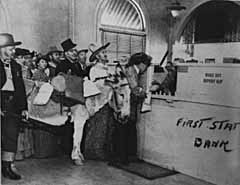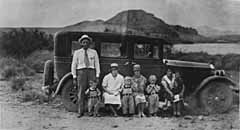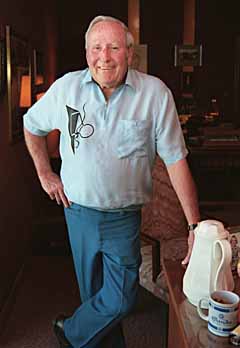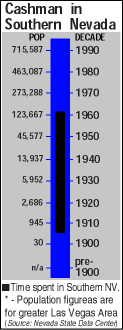Jim Cashman






Big towns run on money, but small ones run on heart. For 40 years, much of Las Vegas’ pulse emanated from the pudgy chest of Big Jim Cashman.
Whether it was starting a baseball team, building a new road, or attracting some new business, Big Jim had a big hand in it. Often, it was two hands and both feet.
His nickname sounds like that of an old-time political boss, bullying people till he got his way. In fact, Big Jim was the opposite. He didn’t drive people, but led them. His tool kit was full of charm, humor, and a logic-defying insistence that everything was FUN. You could prove it by numbers: The more blisters and empty bottles, the more fun you’d had.
The first time he hit town Big Jim didn’t make a dent. It was 1904, Las Vegas was nothing but a tent town on an unfinished railroad, and Cashman was a 19-year-old farm boy from Missouri, looking for work and, according to family tradition, carrying exactly 10 cents. He found work washing dishes and waiting tables in the chow tent of a railroad grading camp. He grew friendly with the cook, Charlie Rowe, and shortly the two quit the railroad to operate a lunch counter in a tent saloon.
“We got along fine and were doing quite a business, but we spent all the money every night that we’d made during the day,” Cashman told interviewer Ed Reid in 1960.
“Finally we decided we weren’t getting ahead, so instead of going out every night, we would go to bed early and save our money. Whoever happened to count the cash when we closed up put it in his pocket, and it happened that the first night we agreed to stay home, Charlie had the money in his pocket.
“I went to bed but Charlie didn’t.” The following morning, Cashman discovered he was back to his original stake of 10 cents. That ended the partnership.
Over the next few years Cashman took whatever jobs he could. One was repairing the neglected telephone system that served the mines around Searchlight, then a bigger town than Las Vegas. “The lines were in such bad shape that whenever the wind blew, the wires would all get crossed up and the poles and lines would fall to the ground,” he told Reid. “I got a team and a wagon with some water barrels and I started out over the line, resetting the poles that had fallen down and pulling up the slack wire.
“After sending back three helpers in a week’s time because they couldn’t keep up, I had earned the reputation of being able to work.” The owners ended up leasing the company to Cashman. On the strength of that concrete accomplishment, Cashman borrowed $500 from his brother and started a sort of rural taxi service. Later, he got a contract hauling ore from local mines, enabling him to borrow money to buy a 5-ton, solid-tire White truck.
To get ore to the railroad at Kingman, he set up his own ferries to cross the Colorado River. They were essentially barges attached to cables and drawn back and forth by gasoline engines mounted on the shore.
“Because he did have those trucks and the auto was just getting started,” explained his son, James Jr., in a 1998 interview, “he had the only repair facility anywhere between Southern California and St. George.” His Searchlight Garage, opened in 1910, became a lifesaving landmark for travelers. He also became an auto dealer; he had no distribution franchise, but could buy from dealers in bigger cities and deliver to local customers.
Because Searchlight was on what passed for a main road in those days, and because Las Vegas was served by a railroad, the auto caught on faster in Searchlight. “When I came into Las Vegas I would have the only car in town,” he told Reid. Sighting an auto would bring media comment such as this item in The Las Vegas Age in June 1912: “James Cashman drove over from Searchlight in his Oldsmobile bringing T.S. Wilson, T.A. Brown, and C.E. Burdick.” But by 1917, he was selling enough autos that the newspaper referred to him as “The Searchlight Automobile magnate.”
Then came Tri-State.
As James Jr. explains it, “Some real estate speculators from California talked his friends into trying to develop Tri-State,” a new town near the intersection of California, Nevada, and Arizona. In September 1921, Cashman and his friends organized a townsite auction on the order of the one that so successfully launched Las Vegas.
“We built a dance platform, hired an Indian band from Needles, and put on a barbecue,” related Big Jim 40 years later.
It was a glorious party lasting two days. There were fist fights, and one drunk decided that a blackjack dealer deserved whipping with “the cat.” He tried to do it with a live feline, who did not cooperate, so both dealer and the black cat escaped unharmed.
But only $2,700 worth of lots were auctioned, and Cashman said later the bidders never paid for even those. The venture, begun on borrowed capital, was $20,000 in the hole.
“That broke him,” said his son. “He was the only one of the partners who had any money and was willing to stand up.” One partner left the country, but Big Jim stayed, and paid it back in three years.
Searchlight’s boom cooled off about that time. Cashman set up a garage next to the Overland Hotel in Las Vegas and gradually came to consider Las Vegas his home. His line of autos expanded to include Buicks, LaSalles, Pontiacs, Oldsmobiles and GMC trucks.
Leah Barker, born and reared in Reno, was the first home economics major to graduate from the University of Nevada, then became an agent for the university’s extension service. She traveled the back roads teaching cooking and housekeeping to farm women. She needed a car for her travels and bought it from Jim Cashman.
“On her first trip, she had to go to Caliente, in Lincoln County,” James Jr. related, “Dad said, ‘I’m going with you to make sure you don’t get in trouble.’ About halfway to Caliente she got a flat tire. He got out of the car, got underneath a bush in the shade and watched her change the tire. She didn’t know how. And she was so mad at him because he wouldn’t help her. He told her what to do, but he made her do it. Said that was the only way she’d learn to do it. ‘I can’t go with you on every trip,’ he told her.”
It made her mad, but Leah married Jim in 1923 and their romance lasted until her death nearly 40 years later. They had a daughter, Tona, born in 1924, and James Jr., born in 1926.
Elected a county commissioner in 1920, Cashman made good roads a primary concern. The main road across Southern Nevada went through Searchlight and bypassed Las Vegas.
“With the Clark County equipment, and the backing of San Bernardino County’s money, they punched a road from Las Vegas up over Mountain Pass into Baker, Calif.,” explained James Jr. The new road opened in 1927 and is today’s Interstate 15.
In 1923 Big Jim and W.H. Pike bought an airplane, hired a pilot, and launched Grand Canyon Scenic Tours. The one-plane airline held the first local airmail contract between Las Vegas and Salt Lake City, but never proved profitable, said James Jr.
Cashman also was a delegate to the League of the Southwest, which was responsible for getting Congress to fund Hoover Dam. In 1929 he had a 25-passenger boat built to run tours of the lake. It lasted 10 years, and it wasn’t a roaring success.
Other ventures were more successful. Frank Crowe, construction superintendent of Hoover Dam, mentioned to Cashman that the dam would require many, many Caterpillar tractors. Big Jim got the Caterpillar franchise.
Hoover Dam was a cash cow for every sort of business, but when it neared completion in 1935, and the free-spending construction crews began moving on, business got slow fast. That year a showman named Clyde Zerby, with previous experience organizing festivals to bring tourism to small towns, pitched the idea here. The Las Vegas Elks lodge sponsored it, named it Helldorado, and got the whole town got behind it. Western movie costumes were rented from Hollywood, most local business people wore them and posed for publicity photos, and touched off a party that has drawn visitors and money annually ever since.
The original celebration was held in a tent village near Sixth and Fremont streets, but Helldorado outgrew that after two years. The Elks decided to build a more permanent facility near Las Vegas Boulevard and Bonanza Road.
Big Jim had property in Lee Canyon, so the Elks spent weekends cutting timber for Helldorado Village, a sort of carnival midway reminiscent of movie-set Western towns.
In 1948 Helldorado needed still more facilities, and again there was little money to build. And again, Big Jim scrounged up the materials and dragooned the labor.
Ed Von Tobel Jr. remembers one Saturday when Big Jim called his father, operator of a local hardware and lumberyard, and within a minute or two, talked Von Tobel into donating an entire railroad carload of cement.
“It was hard to say no to Big Jim,” said Ed Jr.
What emerged was Las Vegas’ first stadium, consisting mostly of concrete bleachers built into a hillside but big and versatile enough to accommodate not only rodeo but also a minor league baseball team and the city’s first exhibition big league game.
Cashman ended up getting most of the credit. The Elks named that stadium Cashman Field; and the Las Vegas Convention Authority retained the name when it built today’s modern stadium on the same site. But Big Jim was always quick to point out that it was a community effort, not his alone.
On his travels to Los Angeles in the 1930s, Big Jim usually stayed at the Hollywood Roosevelt, where he got to know the operator, Tommy Hull. Hull began visiting Las Vegas, and early one morning in 1940, sat with Big Jim at a sidewalk table in front of the Apache Hotel on Fremont Street, having a few drinks. In those wee hours, even Fremont Street was dead, and Big Jim suggested that Hull liven things up by building another hotel here. A drink or two later, Hull decided to do it. El Rancho Vegas became the first big-time resort on the Las Vegas Strip.
Cashman’s business interests suffered while he threw himself into community projects, but he had a plan to resolve that: Tona and James Jr. His parents expected Tona to be the socially graceful and housewifely “Miss Perfect,” said James Jr., but also encouraged her to learn the family business even when it was unfashionable for women to work, and she became vice president and co-owner. Tona Cashman Siefert died in 1996.
James Jr. worked in every department of the automotive business, starting at age 14. And when he came home from World War II, Big Jim told him to forget about college, because he was about to have the whole magilla — car dealership and heavy equipment sales, real estate holdings, and even the chairmanship of the Helldorado parade — dumped into his youthful lap. So James Jr. dutifully went to work.
“He wanted me to run the business so he could do what he wanted,” explained James Jr.
In the early ’50s, local unions tried to organize the auto dealership. The effort was led by Ralph Alsup, Thomas Hanley and Bill Carter. All three were tough; Alsup had served time for wounding a man in a union hall shooting, and to call Hanley a labor racketeer would be letting him off lightly.
The Cashmans fought back with humor. When pickets appeared in front of their house, they tied a mule outside bearing a sign saying “I’m a picket too, but I have an excuse. I was born a jackass.” They had a live monkey on exhibit. When union bosses showed up across the street, they turned on loudspeakers with a recording of Spike Jones giving them the horselaugh. Before it was over, said James Jr., he was receiving death threats, made to his face.
Finally the union men gave up. The Cashmans opened a new auto showroom and invited the whole town.
Two days later, the business burned down. Somehow, in the middle of the night, a 55-gallon drum of paint thinner had overturned and ignited.
“Later that day I got a call from Tom Hanley. He said, ‘You won the battle but I won the war.’ ”
But the war wasn’t over. The Cashmans not only rebuilt, but helped pass a right-to-work law in Nevada.
Alsup was shotgunned to death in 1966 outside his home in Paradise Valley. Hanley and two other men were charged with the murder, but the key witness also was murdered — by firebombing — and Hanley went free. More than a decade later, Hanley kidnapped and murdered Al Bramlet, head of the Las Vegas local of the Culinary Workers Union. Hanley died in 1979, a federal prisoner and one of the most despised men in Nevada history.
Big Jim Cashman died at home in 1962, one of the most beloved. He was 77.
It would be his son and daughter, and grandsons, the late James Cashman III and Tim Cashman, who would turn his small town businesses into the large operations they are today. Each has continued his tradition of volunteerism.
Big Jim was so busy that his son never got to spend as much time with his father as he would have liked. “But it didn’t bother me,” said James Jr. “I was pretty busy doing all the things I was supposed to do. … It taught me that when I got to be his age, I had to contribute myself. And I taught my two sons that. The town has been good to us, the state has, and we’ve got a debt to pay back.
“I loved my dad, and my mother, and if I had my choice, I wouldn’t have changed a thing.”
Part I: The Early Years
Part II: Resort Rising
Part III: A City In Full












